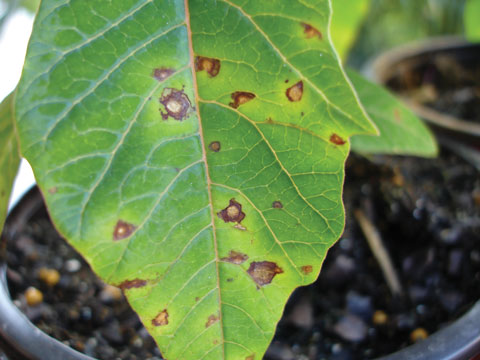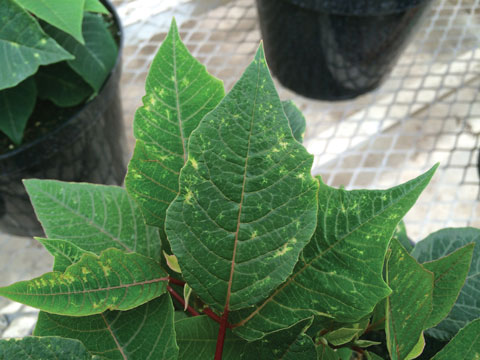5/1/2022
Ensure Successful Poinsettia Production With an Agronomic Plan
Nancy Rechcigl

Pictured: Alternaria leaf spot on poinsettia.
Summer is just around the corner, which means preparations for poinsettia production will begin soon. From propagation to finish, it’s important to watch for common problems, such as Botrytis and whiteflies, that may pose a risk to your crop. Implementing proper cultural practices and developing a preventive insect and disease control strategy ahead of the season is essential to ensure high-quality crops.
Prevention starts with cultural practices
Poinsettias are susceptible to a wide variety of insects and diseases, so thorough scouting is essential to prevent their spread. Greenhouse sanitation is one of the best measures for prevention, as many pathogens can remain dormant and insects can survive on plant debris, under benches and in areas outside the greenhouse. Poinsettia pests you may encounter include:
Botrytis: Botrytis is the most common disease that affects ornamental plants. Initial infections appear as water-soaked spots on foliage and flowers that turn into gray mold once the disease is established. To reduce the threat of Botrytis, create a clean, dry growing environment and scout frequently. Look out for symptoms, including small, light brown spots on flowers; V-shaped, tan-brown lesions on foliage; and plant wilting. Botrytis is particularly threatening during propagation and at the end of production when plants are ready to ship, so scout frequently during these stages.
Powdery mildew: Poinsettias produced in cooler regions are at a higher risk of powdery mildew infections. Fungi form white, talcum-like spots called “colonies” on leaves, stems, flowers and the bracts of the plant. If uncontrolled, the fungus increases in size and number to cover the poinsettia’s surface. Leaves begin to turn yellow, then brown, before eventually dropping. Check incoming plants for disease and remove diseased plants immediately to limit spore production and spread. Scout fully expanded leaves weekly, particularly in the lower to mid-canopy where air movement may be limited.
Alternaria and Xanthomonas leaf spots: Often found at the beginning of production, Alternaria leaf spot can be mistaken for bacterial leaf spot caused by Xanthomonas axonopodis. Carefully examine the shape of the spot. Alternaria leaf spots begin as semi-rounded lesions with a tan center and dark margins. They’re often surrounded by chlorosis, a yellowing of leaf tissue. Leaf spots caused by Xanthomonas axonopodis turn dark brown or black, and are limited by the veins, which give them an angular shape. Keep excess water off poinsettia foliage to help reduce the spread and severity of leaf spots.
Rhizoctonia Crown and Root Rot: This rot is caused by the pathogen Rhizoctonia solani and can infect poinsettias at any stage of production. Look for dry, sunken cankers on the lower plant stem at the soil line as infection starts in roots that are in the upper layer of the growing medium. Once the infection reaches the crown, the plant will wilt and leaves will turn yellow.
Whiteflies: Whiteflies are one of the most common insects found in nursery and greenhouse operations. They feed on plants with piercing, sucking mouthparts, causing the infected foliage to become mottled and drop. Scout the undersides of leaves, as this is where nymphs and eggs can be found, and monitor for adults with yellow sticky cards. Keep production areas free of weeds, which are possible sites of contamination. Lastly, look for evidence of black, sooty mold on leaves, which is honeydew secreted from the insects.
Thrips: Thrips are small, elongated insects that feed by scraping and piercing plant tissue and sucking out the sap and cellular contents, resulting in scarring and distortion. Visually inspect the undersides of poinsettia leaves for immature stages of thrips. Adults can fly and be easily carried into a greenhouse by the wind or on clothing. Screen fans, vents and greenhouse openings to prevent thrips from entering.
Proper cultural practices provide the foundation for insect- and disease-free operations. Follow a strict schedule, examine plants often for signs of insects and diseases, and maintain greenhouse sanitation to reduce the pest threats to your crops. However, rigorous sanitation and detailed inspection processes are sometimes not enough to prevent all threats. Adopt an agronomic program to have a plan in place if further action is needed for control.
Take the next step with an agronomic program
An agronomic program provides the framework for rotating plant protection products based on their strengths and modes of action, so they can provide maximum benefit when needed most. Plus, rotating different modes of action provides a built-in resistance management strategy. Pests become more difficult to control when they develop a resistance to certain chemistries. By rotating products with different modes of action, pests don’t have the chance to develop a resistance to the active ingredient they’re exposed to. Rotate products from at least three to four different classes of chemistries for each insect or disease target.
Whether you’re starting production from propagation or transplanting from liners, Syngenta has developed a complete agronomic program for poinsettias that provides recommendations to control and prevent common insects and diseases that can impact the health of your crop. The program includes Mainspring GNL insecticide, which shields crops from chewing and sucking insects, including thrips and whiteflies. A neonicotinoid alternative, Mainspring GNL is powered by a novel active ingredient in IRAC Group 28. It can be applied as a spray or drench and provides systemic and translaminar movement to prevent pest populations from building to damaging levels.
 Pictured: Poinsettia showing signs of thrips damage.
Pictured: Poinsettia showing signs of thrips damage.
For the 2022 season, the program now includes Postiva fungicide, the latest innovation from Syngenta. With active ingredients in FRAC Groups 3 and 7, this broad-spectrum fungicide is an excellent rotation partner to diversify programs. Postiva provides reliable control of difficult diseases, such as Botrytis and powdery mildew, as well as suppression of bacterial diseases such as Xanthomonas spp.
Poinsettia production is impacted by variable conditions depending on region. An agronomic program is a guide for growers to prevent and control various pests that can threaten crop quality. The frequency of applications should be based on the activity of the product, current environmental conditions, pest lifecycle and level of pressure. An effective program will focus on the best long-lasting, preventive treatments to help save time and resources compared to corrective actions after crops have been compromised.
Take control of pests in your operation with an effective poinsettia protection plan. With regular monitoring, proper cultural practices and an agronomic program, you can keep pests from standing in the way of success. GT
View the poinsettia agronomic program at: GreenCastOnline.com/Solutions.
Nancy Rechcigl is technical services manager for ornamentals for Syngenta.